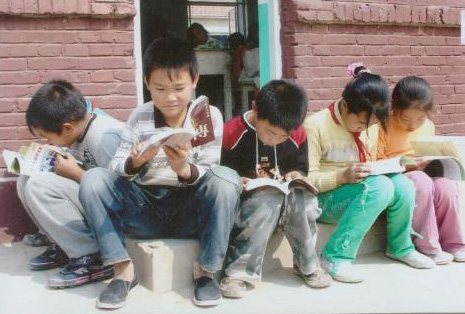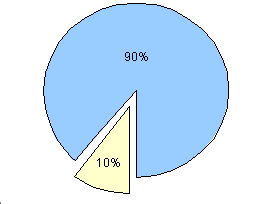90% of donated funds goes directly to the beneficiaries, as books, scholarships, or other forms of assistance.

FOCAL POINTS
- Rural Youth Science Ca...
09/13/2024
- Rural Education in the...
1/1/2023
- The Tin Ka Ping Founda...
12/2022
- Sanhe Library in 2021
12/02/2021
- Foreword: ESS Opens a ...
03/01/2021
- 2020 Innovative Teachi...
- 2019 Teacher Training ...
- 2019 Summer Camps for ...
- a. Science Summer Camp...
- b. Science Camps in Wu...
- c. Science Camps in Ch...
- d. Science Camps in In...
- e. Summer Camps in Hun...
- 2016 ESS Financial Aid...
- 2016 ESS Adopt A Rural...
- Taking on Three Decade...
- On Producing the ESS DVD
05/09/2009
- Improve Teaching and L...
- SERC Program Diagram
- SERC Program Results
- NBC Feature on ESS
10/19/2007
Support Education in Rural China (SERC)

SERC Program Series - Major Resuts and Activities
Program Evaluation and Accountability
The SERC Program Series
"What can we do for them?" This was the question that ESS staff kept asking themselves after visits to poor villages in rural China in the 1980s. They saw how deprived the rural schools were, how little material the rural teachers have to help them teach, and how few books the rural children have to read. Being a small non-profit organization with limited resources, ESS could not solve big problems but could perhaps help in some small ways. As a first step, ESS decided to launch a project to help rural schools set up libraries, to provide the means for rural children to acquire the basic skills of reading and writiing. That marked the beginning of the SERC Program Series.
Over the past decades, the SERC Program Series has evolved to encompass many activities other than the provision of rural school libraries. To ensure that the SERC Program Series continues to be effective in meeting the changing needs of education in rural China, ESS reviews its policies and implementation details every now and then. Many adjustments have been made, and new projects have been developed and implemented. The Program continues to focus on three major themes:
- providing readng and informational material to rural schools;
- improving the quality of teaching and learning in rural schools; and
- providing financial assistance to rural students.
In practice, many of the SERC projects work across all three themes.
Click to view the Diagram of the SERC Program Series.
Click to view the Major Results and Activities of the SERC Program Series, 1988-2012.
The growth of the SERC Program reflects the multi-dimensional needs of education in rural China. Its successful implementation depends on the sustained enthusiasm and dedication of our volunteers in the US and in the different localities in China. Its effectiveness is measured not by the amount of dollars spent, but by the number of China's rural children whose lives have been enriched and empowered.
For more information on specific program activities, please click on the menu links on the left side of this page.
The Role of ESS
ESS serves as a bridge between the sponsors and the beneficiaries of the SERC programs. It is responsible for program planning, fundraising, coordination, implementation and supervision. It sets the rules and regulations for each SERC program. It pilots all new programs and makes necessary adjustments and amendments before taking them to an expanded scale.
Program implementation is facilitated by local representatives in China according to rules and regulations set by ESS. They work with local educational institutions and communities to identify schools and students to be supported by the SERC programs, provide liaison and support through every step of program implementation, and ensure that the targeted funds from ESS are handled and used properly.
Funding of the SERC Programs
The SERC programs are funded by private donations from individuals, non-profit organizations, private enterprises, foundations, and social groups and institutions. Sponsors may designate their contributions to specific program activities or authorize ESS to allocate the funds according to need. The flexible structure enables sponsors to support education in rural China through a range of activities and funding options.
Distribution of Donated Funds
|
ESS has been able to keep an extremely low expense-to-donated funds ratio because it has no paid staff and does not rent any office space. At least 85-90% of donated funds go directly to the beneficiaries as scholarship awards or for the purchase of library books and other equipment or facilities. Only 10% or less of donations are used for administrative expenses in China and the USA, comprising the costs of postage, printing, telephone and fax communication, and domestic transportation for local representatives in China. About 5% of donations for the ARSL projects support activities is used for activities to improve teaching and learning in rural schools (e.g., essay contests and conferences on basic education) |
 |
Program Evaluation and Accountability
- ESS accounts are audited by a registered accounting firm in the US each year.
- ESS sets the rules and regulations for the administration of each program, including the division of responsibilities, provision of feedback material, and regular assessment of program effectiveness.
- ESS local representatives in China are required to submit annual performance and financial reports on the projects for which they are responsible.
- Sponsors receive feedback documentation for each activity they support, and are encouraged to correspond directly with and visit the schools and/or students they have supported.
- ESS maintains a database with detailed records on all the projects.

